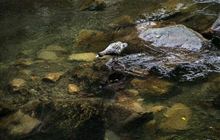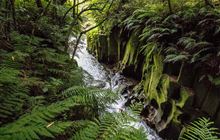Over 100 ducklings make for a loved up Valentine’s Day
Archived content: This media release was accurate on the date of publication.
Introduction
DOC rangers and volunteers have been given a lovely Valentine’s Day gift with more than 100 whio ducklings sighted on a recent survey in the Whirinaki Te Pua-a-Tane Conservation Park in the central North Island.Date: 14 February 2019
DOC Ranger Jacob De Vries says a recent survey confirmed at least 107 ducklings had hatched on the rivers in the park. “Considering there are only an estimated 3000 whio left in the world, over 100 whio chicks in one security site is an outstanding result.”
The work to survey the ducklings wouldn’t have been possible without some help. Six volunteers along with Beau the detection dog and his handler DOC ranger Andrew Glaser all spent long stints wading through the crystal-clear and ice-cold rivers.
Volunteer John Black was so committed to counting ducklings he even spent New Year’s Eve at Central Whirinaki Hut. “Whio are masters of disguise who look just like stones in the river until they move. Seeing new chicks is really rewarding – they are little fluff balls that never stray too far away from their parents,” said John.
The good results can be attributed to the increasing number of adult breeding pairs in Whirinaki Forest and the support of Genesis, which through ongoing support is enabling DOC to double the number of whio breeding sites, boost pest control efforts and enhance productivity and survival for these rare native ducks.
Genesis General Manager Corporate Relations and Whio Forever committee member, Emma-Kate Greer, said that these results show real progress is being made in restoring whio numbers in predator protected security sites. “What an amazing Valentine’s Day present for this hard-working DOC team. These whio ducklings are living proof that the team’s diligence, care and energy in protecting this species is paying off.”
There are currently 38 adult breeding pairs, and hundreds of kilometres of traplines in Whirinaki to protect vulnerable nesting mothers and ducklings from the threat posed by introduced pest species such as rats and stoats. Without pest control, nest cameras show that nearly 95% of nests fail in unmanaged areas.
In addition to trapping, the Whirinaki also benefits from regular pest control operations. Because the Whirinaki Forest is an ideal environment for whio, when pests are managed the population grows rapidly. As these ducklings grow-up they may travel to adjacent forests and repopulate areas that no longer have whio, further helping the species’ long-term success.
The Whirinaki Forest is one of the best places in the world to see whio. The majority of the park’s easy tramping tracks follow rivers and pass directly through the security site. In particular, the Whirinaki Track and the Moerangi Track offer overnight experiences, backcountry huts, and plenty of opportunity to see whio.
Background Information on whio
Whirinaki
- Whirinaki Te Pua-a-Tāne Conservation Park is one of eight ‘whio security sites’ in New Zealand
- 1800 DOC200 traps protect the Whirinaki Whio Security Site; the traps are checked every two weeks
- Whirinaki Forest is home to 51 endangered species including short-tailed bats, kaka, kakariki, kiwi, and rare plants
- Whirinaki Forest has 155km of tramping tracks, nine backcountry huts, and two MTB tracks
- Whirinaki is jointly managed by DOC with Te Runanga o Ngati Whare
- The whio is a threatened species of native duck that is only found in New Zealand’s fast flowing waters. Featured on New Zealand’s $10 note and with an estimated nationwide population of less than 3000 birds, whio are rarer than kiwi
- Whio are adapted to live on fast-flowing rivers so finding whio means you will also find fresh, fast-flowing water with a good supply of plants and underwater insects
- This makes whio important indicators of ecosystem health – they only exist where there is quality fresh water and an abundance of life
Whio Forever
- Genesis has a strong historic association with whio through the Tongariro Power Scheme and in 2010 this association grew through the establishment of Whio Awareness Month (March).
- Today, Genesis and DOC continue their partnership through the Whio Forever Project, which aims to secure the future of whio in the wild and ensure New Zealanders understand and value whio in our rivers.
- The support of Genesis and the work of DOC has enabled the Whio Recovery Plan to be implemented
Conservation issue
- The whio are predated by stoats, ferrets and cats with the largest impact during nesting time when eggs, young and females are vulnerable, and also when females are in moult and can’t fly.
- Extensive trapping can manage these predators and work in key whio habitats by DOC and Genesis on the Whio Forever Project has already seen an increase in whio numbers
- Whio cannot be moved to predator-free islands like other species because of their reliance on fast-flowing rivers.
- Pairs occupy approximately 1 km of water – so they need a lot of river to sustain a large population and they fiercely defend their territories, which makes it difficult to put them with other ducks in captivity.
- They are susceptible to flood events which, destroy nests, fragment broods and wash away their valued food source.
Contact
For media enquiries contact:
Email: media@doc.govt.nz


